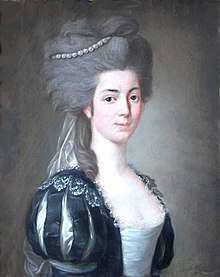
Back ليونور د الميدا پورتوجال ARZ Leonor de Almeida Portugal Catalan Leonor de Almeida Portugal, markýza de Alorna Czech Leonor de Almeida Portugal Welsh Leonor de Almeida Portugal German Leonor de Almeida Portugal Spanish Leonor d'Almeïda French Leonor de Almeida Portugal ID Leonor de Almeida Portugal Italian Leonor de Almeida Portugal Portuguese
The Marquise of Alorna | |
|---|---|
 Portrait by Józef Pitschmann (1780) | |
| Born | Leonor de Almeida Portugal de Lorena e Lencastre 31 October 1750 Lisbon, Kingdom of Portugal |
| Died | 11 October 1839 (aged 88) Lisbon, Kingdom of Portugal |
| Resting place | Cemitério dos Prazeres, Lisbon |
| Pen name | Alcipe |
| Occupation | Poet, writer, painter |
| Language | Portuguese |
| Period | Romanticism |
| Spouse | Count Carlos Pedro Maria José Augusto of Oyenhausen-Grevenburg |
| Relatives | João de Almeida Portugal, 2nd Marquis of Alorna (father) Leonor de Lorena e Távora (mother) |
D. Leonor de Almeida Portugal, 4th Marquise of Alorna, 8th Countess of Assumar (31 October 1750 – 11 October 1839) was a Portuguese noblewoman, painter, and poet. Commonly known by her nickname, Alcipe, the Marquise was a prime figure in the Portuguese Neoclassic a proto-Romantic literary scene, while still a follower of Neoclassicism when it came to painting.[1]
Leonor was born into one of the many branches of the House of Távora, Portugal's most illustrious and powerful noble family at the time. This being said, the time of her birth and the subsequent years were a time of great trouble for the House of Távora, as they had been accused of treason against King José I of Portugal, in a series of events known as the Távora affair. Because of the unfortunate events in her early childhood, Leonor spent nineteen years forcibly imprisoned in a convent, where she spent most of her time reading and writing poetry. Her early success as a poet at the convent started her lifelong career which would lead her to becoming one of Europe's most noteworthy literary figures at the time.
The occupation of Leonor's husband, Count Carlos Pedro of Oyenhausen-Groewenbourg, as a diplomat in the service of Queen Maria I of Portugal, meant that Leonor and her family spent much of their lives traveling the courts of Europe, most notably the Austrian Imperial Court at Vienna. Her travels allowed Leonor to acquaint herself with many of Europe's great minds of the time, thus spreading her literary and artistic influence throughout the continent and expanding Leonor's views and perceptions, both in poetry and in painting.
- ^ Anke Gilleir; Alicia C. Montoya; Suzan van Dijk, eds. (2010). Women Writing Back/ Writing Women Back : transnational perspectives from the late Middle Ages to the dawn of the modern era. Leiden: Brill. ISBN 978-9004184633.